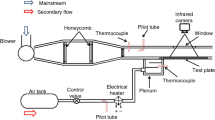Abstract
Film cooling performance about a row of dual-fanned holes with injection angles of 30°, 60 ° and 90° were experimentally investigated at blowing ratios of 1.0 and 2.0. Dual-fanned hole is a novel shaped hole which has both inlet expansion and outlet expansion. A transient thermochromic liquid crystal technique was used to reveal the local values of film cooling effectiveness and heat transfer coefficient. The results show that injection angles have strong influence on the two dimensional distributions of film cooling effectiveness and heat transfer coefficient. For the small injection angle of 30 degree and small blowing ratio of 1.0, there is only a narrow spanwise region covered with film. The increase of injection angle and blowing ratio both leads to the enhanced spanwise film diffusion, but reduced local cooling ability far away from the hole. Injection angles have comprehensive influence on the averaged film cooling effectiveness for various x/d locations. As injection angles are 30 and 60 degree, two bands of high heat transfer coefficients are found in mixing region of the gas and coolant. As injection angle increases to 90 degree, the mixing leads to the enhanced heat transfer region near the film hole. The averaged heat transfer coefficient increases with the increase of injection angle.
Similar content being viewed by others
References
R. S. Bunker. A Review of Shaped Hole Turbine Film-Cooling Technology[J]. Journal of Heat Transfer, 2005, vol.127, pp. 441–453.
R. J. Goldstein, P. Jin, R. L. Olson, “Film Cooling Effectiveness and Mass/Heat Transfer Coefficient Downstream of One Row of Discrete Holes”[J]. Journal of Turbomachinery, 1999, vol.121, pp. 225–232.
Guang-chao Li, Wei Zhang, “Improving Film Cooling Performance by Using One Inlet and Double Outlet Hole”, [J], Journal of Thermal Science, 2010, vol.19, pp. 430–437.
X. Yang, Z. Liu, Z. P. Feng, “Numerical Evaluation of Novel Shaped Holes for Enhancing Film Cooling Performance”, [J]. Journal of Turbomachinery, 2015, vol.137: 071701.
C. H. Lim, G. Pullan, P. Ireland, “Influence of Film Cooling Hole Angles and Geometries on Aerodynamic Loss and Net Heat Flux Reduction”, [J]. Journal of Turbomachinery, 2013, vol.135: 051019.
S. P. James, E. S. Jane, J. W. Gregory, et al, “A Comparative Investigation of Round and Fan-Shaped Cooling Hole Near Flow Fields”, [J]. Journal of Turbomachinery, 2008, vol.130: 041020.
X. Z. Zhang, I. Hassan, “Film Cooling Effectiveness of an Advanced-Louver Cooling Scheme for Gas Turbines”, [J]. Journal of Thermophysics and Heat Transfer, 2006, vol.20, pp.754–763.
A. Kohli, K. A. Thole, “Entrance Effects on Diffused Film-Cooling Holes”, 1998, ASME Paper 98-GT-402.
FAN Hui-ming, ZHU Hui-ren, LI Guang-chao. “Experiments of Discharge Coefficient of Film Cooling Holes Under Adverse Pressure Gradient”, [J]. Journal of Propulsion Technology, 2009, vol.30, pp. 405–410.
C. H. N. Yuen, R. F. Martinez-Botas, “Film Cooling Characteristics of a Single Round Hole at Various Streamwise Angles in a Crossflow: Part I Effectiveness”, [J]. International Journal of Heat and Mass Transfer, 2003, vol. 46, pp.221–235
C. H. N. Yuen, R. F. Martinez-Botas, “Film Cooling Characteristics of a Single Round Hole at Various Streamwise Angles in a Crossflow: Part II Heat Transfer Coefficients”, [J]. International Journal of Heat and Mass Transfer, 2005, vol. 48, pp.5017–5035.
S. V. Ekkad, J. C. Han, “Transient Liquid Crystal Thermography Technique for Gas Turbine Heat Transfer Measurements”, [J]. Measurement Science and Technology, 2000, vol.11, pp. 957–968.
M. R. Anderson, J. W. Baughn, “Liquid-Crystal Thermography Illumination Spectral Effects. Part 1—Experiments”, [J]. Journal of Heat Transfer, 2005, vol.127, pp.581–587.
Acknowledgment
This study was supported by the National Natural Science Foundation of China (Grant No. 51406124) and by the Natural Science Foundation of Liaoning Province of China (Grant No. 201602576).
Author information
Authors and Affiliations
Corresponding author
Additional information
This study was supported by the National Natural Science Foundation of China (Grant No. 51406124) and by the Natural Science Foundation of Liaoning Province of China (Grant No. 201602576).
Rights and permissions
About this article
Cite this article
Li, G., Wang, H., Zhang, W. et al. Film cooling performance of a row of dual-fanned holes at various injection angles. J. Therm. Sci. 26, 453–458 (2017). https://doi.org/10.1007/s11630-017-0961-4
Received:
Published:
Issue Date:
DOI: https://doi.org/10.1007/s11630-017-0961-4




